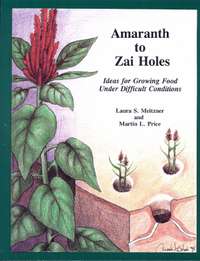Amaranth to Zai Holes
 AMARANTH TO ZAI HOLES; Ideas for growing Food Under Difficult Conditions (1996)
AMARANTH TO ZAI HOLES; Ideas for growing Food Under Difficult Conditions (1996)
Laura S. Meitzner and Martin L. Price
This is a book of practical ideas. It is written for people who help those who live and make their living under difficult conditions in the tropics and subtropics. What should a development worker do to assist a community? There are no simple answers, but there are many possibilities--plants, techniques, and technologies--which hold potential. For fifteen years, ECHO has sought out information on these ideas for the quarterly networking bulletin ECHO Development Notes (EDN). Many people have contributed their insights to share with our network of over 4000 people in 140 countries. If you are interested in improving the lives of small farmers, we welcome your active participation in our network.
This book is based on the first 51 issues of EDN. The ideas in EDN come from questions or experiences of field workers, the scientific research done in support of their work, and many newsletters from around the world which ECHO's staff monitor for worthy items. This collection is not intended to be a complete handbook. There are important topics which are not mentioned, and in many cases you are referred to other resources for background information or specialized details.
More and updated information is available in Agricultural Options for the Small Scale Farmer and in ECHO Publications.
Over 150 issues of EDN have now been published.
The complete Amaranth to Zai Holes can be downloaded here or download a selected chapter below.
ECHO library copies can be viewed on-site in Florida or Thailand. A 2001 Video about ECHO, produced by The Visionaries, can be viewed online.
| First | Second | Third | Fourth | Fifth | Last |
44 Issues in this Publication (Showing issues 20 - 5) Previous | Next
Comparison Charts of Tropical Crops - 19.10.1996
By Franklin W. Martin and Michael P. Fennema
The questions of what crops should be grown and how they should be used are never completely answered. Furthermore, there is no document or person that can provide all the answers desired. Agriculture always involves trial and error, experimenting and risking, learning and adjusting. These charts supply you with information to help you in making choices about which crops to try in your location. Crops are compared by categories to permit selection based on knowing how the crop can tolerate the conditions in your area. These comparison charts complement ECHO's catalog of "Seeds Available from ECHO," although the charts include a broader range of crops than offered in the catalog. It serves as another basic source of imformation on the most important crops of the tropics.
Chart 1 - A Comparison of Grain Crops
Chart 2 - A Comparison of Leguminous Vegetables (See also Grain Legumes)
Chart 3 - A Comparison of Pulses (Dried Legumes used for Cooking)
Chart 4 - A Comparison of Fruit Vegetables
Chart 5 - A Comparison of Vegetable Leaves
Chart 6 - A Comparison of Roots and Tubers
Chart 7 - A Comparison of Miscellaneous Vegetables
Chart 8 - A Comparison of Selected Tropical Fruit Crops
Chart 9 - A Comparison of Nut Crops
Chart 10 - A Comparison of Industrial, Plantation, or Beverage Crops
Chart 11 - A Comparison of Ground Covers and Green Manures
Chart 12 - A Comparison of Tropical Pastures and Field Crops
Chart 13 - A Comparison of Special Purpose Trees
Chart 1 - A Comparison of Grain Crops - 19.10.1996
All these grain crops are annuals and are propagated by seed.
Chart 2 - A Comparison of Leguminous Vegetables (See also Grain Legumes) - 19.10.1996
All plants are propagated by seed; winged beans may also be propagated by tubers.
Chart 3 - A Comparison of Pulses (Dried Legumes used for Cooking) - 19.10.1996
All are propagated by seed, the scarlet runner may also be propagated by roots.
Chart 4 - A Comparison of Fruit Vegetables - 19.10.1996
All plants listed are daylength neutral and are propagated by seeds; chayote, pumpkin and tomatoes can also be propagated by cuttings.








